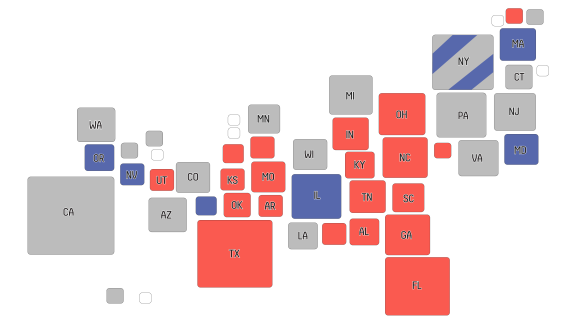https://fivethirtyeight.com/features/republicans-won-almost-every-election-where-redistricting-was-at-stake/
Joe Biden may have won the White House, but down-ballot races were much better for Republicans. In fact, the GOP’s victories in state-level elections could pay dividends long after Biden leaves office, thanks to their influence over next year’s redistricting process.
[Related: Republicans Are On Track To Take Back The House In 2022]
Every 10 years, after the census, congressional and state legislature districts are redrawn to account for population changes. This gives whoever is drawing the maps the power to maximize the number of districts that favor their party — a tactic known as gerrymandering. And as we wrote last month, the 2020 election represented the last chance for voters to weigh in on who would draw those maps. Both parties went into the election with a chance to draw more congressional districts than the other, but the end result was just about the best-case scenario for Republicans. As the map below shows, Republicans are set to control the redistricting of 188 congressional seats — or 43 percent of the entire House of Representatives. By contrast, Democrats will control the redistricting of, at most, 73 seats, or 17 percent.

How did Republicans pull that off? By winning almost every 2020 election in which control of redistricting was at stake:
- The GOP kept control of the redistricting process in Texas by holding the state House. Given that Election Data Services estimates Texas will have 39 congressional seats for the next decade, this was arguably Republicans’ single biggest win of the 2020 election.
- Republicans successfully defended the Pennsylvania legislature from a Democratic takeover, although they’ll still need to share redistricting power over its projected 17 congressional districts, as Democratic Gov. Tom Wolf has veto power.
- Republicans held the majority in both chambers of the North Carolina legislature, which will enable them to draw an expected 14 congressional districts all by themselves.
- Amendment 1 passed in Virginia, taking the power to draw the state’s 11 congressional districts out of the hands of the all-Democratic state government and investing it in a bipartisan commission made up of a mix of citizens and legislators.
- In Missouri (home to eight congressional districts), Gov. Mike Parson was elected to a second term, keeping redistricting control in Republican hands.
- In an upset, Republicans managed to keep their majority in the Minnesota state Senate, thus ensuring Democrats wouldn’t have the unfettered ability to draw the state’s projected seven congressional districts. The parties will share redistricting responsibilities there.
- The GOP kept control of the state House in Iowa, with its four congressional districts.
- Republicans maintained their supermajorities in the Kansas Legislature, enabling them to pass a new congressional map (worth four districts) over Democratic Gov. Laura Kelly’s veto.
- Finally, Republicans surprisingly flipped both the state Senate and state House in New Hampshire (worth two congressional districts), seizing full control of both the state government and the redistricting process.
The one state where Republicans may not have gotten their preferred outcome is New York, where we still don’t know who will control the redistricting process because the state is taking so long to count absentee ballots. If Democrats win a supermajority in the state Senate, they will have total veto power over the state’s projected 26 congressional districts. Democrats are close to clearing that bar, but we won’t know if they make it for, potentially, weeks.
Polls were off for the 2020 election, but not by much | FiveThirtyEight
Regardless of the outcome in New York, the overall redistricting picture is the same: The GOP is in almost as good a position as it enjoyed in the last redistricting process, when Republicans controlled the drawing of 55 percent of congressional districts and Democrats controlled only 10 percent after 2010’s GOP wave. As a result, the House map has been more biased toward Republicans this decade than at any point since the 1970s (and Republicans have been able to win multiple chambers in state legislatures despite losing the statewide popular vote1). It now looks as if we’re headed for another 10 years of Republican-favoring maps. Democrats were able to win the House and several state legislatures in 2018 thanks to shifting vote patterns in the suburbs in particular, but Republicans in many states will now have the opportunity to draw new gerrymanders that account for this realignment.
That said, the House map overall might still be less biased in the 2020s than it was in the 2010s. While it’s true that Republicans are set to draw many more congressional districts than Democrats, they will still draw fewer than they did in 2011. In addition, at least 167 districts,2 or 38 percent of the House, will be drawn by independent commissions or by both parties sharing power.3 That’s up from 145 (33 percent) in 2011, in part because states such as Colorado, Michigan and Virginia passed redistricting-related ballot measures in recent years. These reforms should translate into fewer gerrymandered seats overall — by either party.
Furthermore, some redistricting processes still controlled by one party — think Ohio’s or Utah’s — have new rules in place designed to encourage more neutral maps. So ultimately, we’ll have to wait and see what the often-messy redistricting process produces in each state — and you can rest assured that will be a major focus of FiveThirtyEight’s coverage in 2021.
Nathaniel Rakich is an elections analyst at FiveThirtyEight. @baseballot
Elena Mejía is an associate visual journalist at FiveThirtyEight. @elena___mejia














